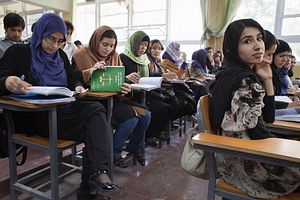Afghanistan’s next president will most certainly be male, but its future will be written at least in part by the country’s women.
Since the Taliban were ejected 12 years ago, women have taken an active part in Afghanistan’s government and civil society. Women are parliamentarians, lawyers, athletes, businesswomen, musicians, and more than ever before, they are role models for a younger generation of girls. Presidential candidate Zalmai Rassoul’s second running mate was Ms. Habiba Sarabi, who stepped down as governor of Bamiyan province to run for office.
While the situation for many women is often abysmal, not all Afghan women can be viewed as powerless victims. Women in Afghanistan are attaining leadership and power positions, despite being harassed and threatened for challenging fixed gender roles in a traditional society. During this transitional year for Afghanistan, women are appearing in public office and at the negotiating table. They will be a vital part of the peace-building process when negotiations with the Taliban commence. Despite challenges, risks, and targeted attacks, one thing remains clear: none of these women leaders is willing to give up what she has achieved.
Anna Loshkin is a photographer and journalist based in London. To see more of her work, visit www.annaloshkin.com.









































